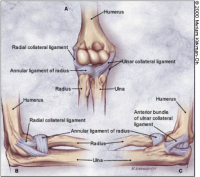Elbow Varus Stress: Difference between revisions
mNo edit summary |
Evan Thomas (talk | contribs) mNo edit summary |
||
| Line 2: | Line 2: | ||
'''Original Editor '''- [[User:Tyler Shultz|Tyler Shultz]] | '''Original Editor '''- [[User:Tyler Shultz|Tyler Shultz]] | ||
'''Lead Editors''' | '''Lead Editors''' - | ||
</div> | </div> | ||
The purpose of the varus stress test of the elbow is to assess the integrity of lateral collateral ligament. <br> | == Purpose == | ||
The purpose of the varus stress test of the elbow is to assess the integrity of lateral collateral ligament.<br> | |||
[[Image:Elbow Ligaments.png|thumb|right|200px|Elbow Ligaments]] | [[Image:Elbow Ligaments.png|thumb|right|200px|Elbow Ligaments]] | ||
== Technique | == Technique == | ||
With the patient standing, the therapist places the patient's elbow in slight flexion while palpating the humeroulnar joint line. The therapist then applies a varus force to the elbow. This test is considered positive if the patient experiences pain or excessive laxity is noted compared to the contralateral side.<ref>Flynn, T.W., Cleland, J.A., Whitman, J.M. (2008). User's guide to the musculoskeletal examination: Fundamentals for the evidence-based clinician. Buckner, Kentucky: Evidence in Motion</ref> The test can be repeated in varying degrees of elbow flexion, but generally it is positioned between 5 and 30 degrees.<ref>Dutton, M. (2008). Orthopaedic: Examination, evaluation, and intervention (2nd ed.). New York: The McGraw-Hill Companies, Inc.</ref><br><br> | With the patient standing, the therapist places the patient's elbow in slight flexion while palpating the humeroulnar joint line. The therapist then applies a varus force to the elbow. This test is considered positive if the patient experiences pain or excessive laxity is noted compared to the contralateral side.<ref>Flynn, T.W., Cleland, J.A., Whitman, J.M. (2008). User's guide to the musculoskeletal examination: Fundamentals for the evidence-based clinician. Buckner, Kentucky: Evidence in Motion</ref> The test can be repeated in varying degrees of elbow flexion, but generally it is positioned between 5 and 30 degrees.<ref>Dutton, M. (2008). Orthopaedic: Examination, evaluation, and intervention (2nd ed.). New York: The McGraw-Hill Companies, Inc.</ref><br><br> | ||
| Line 18: | Line 19: | ||
== Evidence == | == Evidence == | ||
Provide the evidence for this technique here | Provide the evidence for this technique here. | ||
== References == | |||
== References | |||
<references /> | <references /> | ||
[[Category:Special_Tests]] [[Category:Elbow]] [[Category:Ligaments]] [[Category:Musculoskeletal/Orthopaedics]] | |||
Revision as of 07:15, 6 December 2017
Original Editor - Tyler Shultz
Lead Editors -
Purpose[edit | edit source]
The purpose of the varus stress test of the elbow is to assess the integrity of lateral collateral ligament.
Technique[edit | edit source]
With the patient standing, the therapist places the patient's elbow in slight flexion while palpating the humeroulnar joint line. The therapist then applies a varus force to the elbow. This test is considered positive if the patient experiences pain or excessive laxity is noted compared to the contralateral side.[1] The test can be repeated in varying degrees of elbow flexion, but generally it is positioned between 5 and 30 degrees.[2]
Evidence[edit | edit source]
Provide the evidence for this technique here.
References[edit | edit source]
- ↑ Flynn, T.W., Cleland, J.A., Whitman, J.M. (2008). User's guide to the musculoskeletal examination: Fundamentals for the evidence-based clinician. Buckner, Kentucky: Evidence in Motion
- ↑ Dutton, M. (2008). Orthopaedic: Examination, evaluation, and intervention (2nd ed.). New York: The McGraw-Hill Companies, Inc.
- ↑ Physiotutors. Elbow Varus Instability Stress Test⎟Lateral Collateral Ligament. Available from: https://www.youtube.com/watch?v=5zl8GsG3hR4







